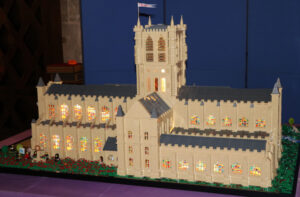

900 Years of the Abbey of Saint Mary, Cirencester
Alan Welsford: Letter to the Wilts and Glos Standard, autumn 2016:
Why Abbey 900?
Dear Sir, Why “Abbey900”? asks one of your correspondents. Because the Abbey was more than just a building.
Though little remains of the structures, there are fifty or more manuscripts which were once in the Abbey Library still extant, including the great Cartulary. The manuscripts were saved by one of Henry VIII’s commissioners who oversaw the Dissolution of the Abbey. These documents reveal the importance of the Abbey not only locally but nationally and in a European context. Several of the abbots were Papal Judges, in its later years the Abbot was summoned to Parliament and one Abbot negotiated a settlement between the King and Barons in revolt against him.
Through the management of their estates in the Cotswolds the Abbot and Canons, (the Abbey was Augustinian with Canons rather than Monks), took the name of the Town far into Europe as the wool produced under their stewardship gained prominence as the best that could be obtained.
The Abbey also brought to the Town many influential people including Kings and the Black Prince. But it is not only in the fields of Church and State politics and in commerce that the Abbey is important.
It was also the home of several notable scholars. Canon Jocelyn is noted as one of the first to understand the significance of the new mathematics arriving from the Middle East in the 10th and 11th centuries.
Robert of Cricklade, who was a Canon here before moving to Oxford, is known as the author of important works.
Then there is Abbot Alexander Nequam, foster-brother of Richard the Lionheart and a noted international scholar who, in the later 12th century, championed the newly re-discovered works of Aristotle and shared in the beginnings of a scientific attitude to learning, the 12th Century Renaissance. Alexander’s memorial in Worcester Cathedral reads “ Wisdom suffered an eclipse. A sun is buried, which, while it lived, every branch of learning flourished. Nequam is dissolved into ashes. Had he one heir on earth, his death would be less cause for tears”
Our medieval inheritance is as worthy of celebration as is our place in Roman Britain.
Alan Welsford. Cirencester
See Alan’s long article on Alexander Neckham, Abbot of the Abbey in our 2017 Newsletter
Richard Reece – from Newsletter no.2 1960
The End of the Abbey of St. Mary
The edict of Henry VIII suppressing the major Abbeys and Monasteries of England hit Cirencester on the morning of December 19th 1539, in the form of Robert Southwell, Richard Poulet, King’s Treasurer, and William Berners, King’s Auditor. These among others received the surrender of John Blake, Abbot, and Richard Woodall, Prior, reporting later to the King that all went smoothly, and everyone, including the monks, seemed satisfied with his treatment. In this way the new year of 1540 brought into Gloucestershire the tremendous clerical system needed to deal with the dissolution of the monasteries, and opened up a short chapter for which documentary evidence abounds, albeit so far untapped.
The events following the suppression of the Abbey make an interesting story which involves especially the King’s wine-merchant Roger Basing. Immediately after obtaining the tenancy of the site on 11th May 1450 (sic) he was unjustly thrown into prison in Spain, and was only released six months later on the plea of King Henry himself to the Emperor Charles V. Basing kept an interest in the tenancy of the site, in spite of all that Fuller, Beecham, Baddeley and others may say, until he sold it to Dr. Richard Master in February 1564. Other characters in the story include the courtiers and county worthies Sir Anthony Hungerford and Sir Anthony Kingston and ill-fated Thomas, Lord Seymour of Sudeley. The violent deaths of the last two meant that the site was each time confiscate to the crown, the same piece of land being sold three times over, and the Treasury as usual, making a handsome profit.
Going back to the original sources it is now possible to give a reasonable account of the passage of the site and buildings from 1539 to their purchase by Dr. Master, and hence to the present day. This research has supplemented the findings of a small excavation which took place by kind permission of Col. W.E. Chester-Master, on the site of the Abbey at Easter 1959. This showed three main phases. Uppermost was the debris of the present Abbey house, built towards 1800, then the debris of the Tudor house of Dr. Master, (c.1590-1780), and beneath that a third layer of mortar rubble containing fragments of moulded stone, stained glass, glazed tiles and 16th century pottery, which bore eloquent witness to the physical fact of the “dissolution” of the monastery.
A full report on the Abbey is now being written and will appear in the Transactions of the Bristol and Gloucestershire Archaeological Society.
Richard Reece Newsletter no.2 Summer 1960.
The Bristol and Gloucestershire Archaeological Society report can be found here published in 1962. A quick search of the BGAS Transactions finds very many references to the Abbey.